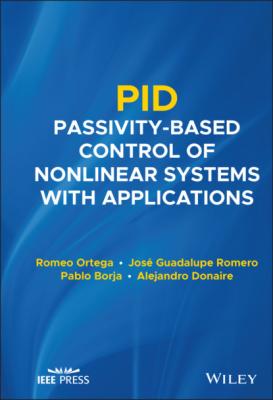PID Passivity-Based Control of Nonlinear Systems with Applications. Romeo Ortega
Чтение книги онлайн.
Читать онлайн книгу PID Passivity-Based Control of Nonlinear Systems with Applications - Romeo Ortega страница 13
 are not discussed in the book. For instance, the need to introduce an anti‐windup mechanism in the presence of saturation, limitations of the derivative gain, filtering the derivative action, and the use of other architectures of the PID. Also, the simplicity of the PID structure imposes limitations, for example on the set of unstable plants that can be stabilized with this class of controller and the difficulty of handling time delays and complex systems. For a detailed discussion of these, and other PID implementation issues, the interested reader is referred to Ang et al. (2005), Åstrom and Hägglund (1995, 2001), and Åstrom (2018).
are not discussed in the book. For instance, the need to introduce an anti‐windup mechanism in the presence of saturation, limitations of the derivative gain, filtering the derivative action, and the use of other architectures of the PID. Also, the simplicity of the PID structure imposes limitations, for example on the set of unstable plants that can be stabilized with this class of controller and the difficulty of handling time delays and complex systems. For a detailed discussion of these, and other PID implementation issues, the interested reader is referred to Ang et al. (2005), Åstrom and Hägglund (1995, 2001), and Åstrom (2018).
2.2 Well‐Posedness Conditions
As discussed earlier, it is necessary to ensure that the control law 2.1 can be computed without differentiation nor singularities. The latter may arise due to the presence of the derivative term
The required well‐posedness assumptions in both cases are stated in the lemma below, whose proof follows immediately computing the expressions of
Lemma 2.2
If the system has relative degree zero, that is , the feedback system of Figure 2.1 with is well‐posed if the matrix
is full‐rank. On the other hand, if the system has relative degree one, that is and , the feedback system is well posed if the matrix
is full‐rank.
Remark 2.3:
As a final comment of this section, we note that in van der Schaft (2016), PID control is viewed from a different perspective. Namely, assuming that
2.3 PID‐PBC and the Dissipation Obstacle
In this section, we reveal a subtle aspect of the practical application of PID‐PBC, namely that for passive systems of relative degree one, there exists a steady state only if the energy extracted from the controller is zero at the equilibrium. The latter condition is known in PBC as dissipation obstacle and is present in many physical systems, for instance, all electrical circuits with leaky energy storing elements operating in nonzero equilibria – i.e. capacitors in parallel, or inductors in series, with resistors. Interestingly, this obstacle is absent in position regulation of mechanical systems since dissipation (due to Coulomb friction) is zero at standstill.
After briefly recalling the nature and mathematical definition of the dissipation obstacle, we prove the claim of inexistence of equilibria stated above in a more general context than just PID‐PBC, namely for all dynamic controllers incorporating an integral action on a passive output of relative degree one.
2.3.1 Passive Systems and the Dissipation Obstacle
To mathematically define the dissipation obstacle of a passive system with storage function
As a corollary of Hill–Moylan's theorem, see Theorem A.1, we see that the only passive output of relative degree one is the so‐called natural output, that we identify with the subindex
Substituting the definition above in 2.2, we can give to it the interpretation of power‐balance equation, where
(2.4)
Notice